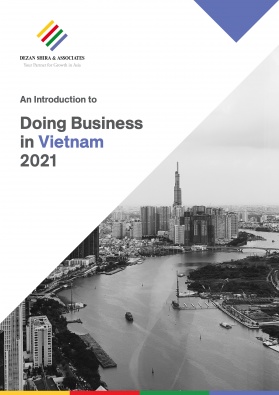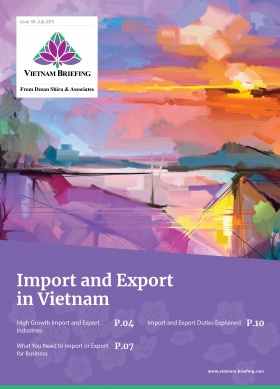Vietnam’s Chu Lai Port – A Key Transit Hub in Central Vietnam
- Chu Lai port in Central Vietnam aims to become a major transit point as a shipping hub for trade and logistics.
- The second biggest after Ky Ha port in Quang Nam province, the Chu Lai port is expected to be a major player in the development of the Central region.
- The port’s high-quality infrastructure and diversified transport routes and services, together with strong investment inflows into Quang Nam province, are key elements contributing to the port’s potential development.
Vietnam’s Chu Lai port aims to become a major transit point for local and international trade in Central Vietnam. Chu Lai port is located in the Chu Lai Open Economic Zone, a destination of 158 investors and US$4.5 billion in total investment. It is currently the second biggest port after Ky Ha Port in central Quang Nam province.
Having commenced operations in 2012, Chu Lai port is in its most prosperous development phase, thriving to become a substantial transit point for Vietnamese and international merchandise. The port benefits from competitive advantages of Quang Nam – a promising investment destination for foreign investors. Looking further ahead, Chu Lai sees a promising future to become a major player in Vietnam’s logistics industry.
Quang Nam and Chu Lai: Key stats
Quang Nam borders Da Nang city and Quang Ngai province to the North and South, respectively. The province extends to 10,406 square kilometers with a population of 1.43 million people. Being one of the five provinces in the key economic regions of central Vietnam, since 2016 Quang Nam has scored high in the Provincial Competitiveness Index (PCI) and remained in the top 10.
Over the years, Quang Nam has experienced a significant upturn in FDI attraction and tourism development. Despite the downsides of the COVID-19 epidemic, Quang Nam attracted over US$33 million in registered FDI capital, maintaining 196 valid projects in the province, with a total registered capital of US$5.93 billion. As a result of the surge in FDI, Chu Lai port has become a popular shipping harbor for foreign investors. The potential of Chu Lai lies in three key factors: high-quality infrastructure, diversified transport routes and services, and attraction of investment into Quang Nam and the Chu Lai Open Economic Zone.
Vietnam Briefing explores these factors below:
1. High-quality infrastructure and equipment
After having been upgraded and put into operation in 2017 by Truong Hai Auto Corporation (THACO), Chu Lai port has contributed greatly to advancing the capacity of the Vietnam logistics chain. In order to meet the needs of various customers, the port has three different functional zones: container, general cargo, and liquid cargo, all of which are designed to serve separate types of goods.
With an extended wharf of almost 500 meters upstream, the port is adept at serving three vessels with a capacity of 20,000 tons simultaneously, including general cargo ships and liquid cargo ships. In addition, the port’s warehouse and workshop systems were also upgraded from 71,040 m2 to 91,200 m2.
To establish optimal productivity, Chu Lai’s equipment was also advanced, with new purchases of loading and unloading equipment: cargo cranes, tire cranes, trucks, tugboats, and forklifts. Due to the high-quality infrastructure and equipment, Chu Lai is capable of serving giant container vessels from foreign business partners. In 2019, the port served a Hong Kong-flagged ship SITC HEBEI, a massive container of 172 meters in length and 22,000 tons in deadweight tonnage, shipping its merchandise from South Korea.
SITC International Holdings Company Limited (SITC) is a top leader in Asia’s logistics and shipping industry and has been using Chu Lai once or twice a week ever since. Seeing great opportunities and advantages, SITC stated that in the near future they will dock heavier carriers at Chu Lai at an average rate of once every week. Apart from SITC, most recently, a Laos-based company – Sun Paper Savannakhet – shipped 7,200 tons of paper pulp through Chu Lai as a transit point on its export route to China.
Producing 400,000 tons of recycled pulp annually for the Shandong Sun Paper Industry in China, Sun Paper Savannakhet chose Chu Lai due to its high-quality infrastructure, equipment, and shipping route. This major Laos-firm stated that they aim to ship approximately 180,000 tons of paper pulp through Chu Lai in 2021, which is a monthly quantity of about 15,000 tons.
2. Diversified transport route and services
Apart from high-quality infrastructure, Chu Lai is a potential major transit point for foreign investors due to the diversity in its transport route and services. Besides transporting goods and merchandise, the port also provides towage and rescue services, tallying and storing, freight forwarding and shipping agents, wharf services, and other related ship services, providing investors with a full-package service chain.
Regarding marine transportation, besides domestic transport routes, Chu Lai also serves two-way transport routes for foreign partners: Chu Lai – Fangcheng (China) and Chu Lai – Incheon (South Korea). Looking further ahead, Chu Lai is expected to expand its routes internationally to other major shipping ports such as South Korea, China, Japan, and other countries in order to serve more foreign partners.
3. Investment inflows
The attraction of investment plays a major role in providing growth opportunities for Chu Lai. In 2020, Quang Nam called for a public private partnership (PPP) investment in Chu Lai Open Economic Zone, Chu Lai airport, and seaport systems, bringing the potential for further upgradation of the Chu Lai port.
The investment is expected to advance Chu Lai and Ky Ha port to host ships with a deadweight tonnage of 50,000, serving a total of 12.7 million tons of cargo annually, starting from 2030. This PPP model will increase productivity and capacity of operation and management of Chu Lai and the entire seaport systems of Quang Nam province. Quang Nam plans to accelerate procedures and advance construction plans for seaports to serve potential customers and investors.
Moreover, the inflows of investment will attract foreign firms, encouraging them to use the Chu Lai port due to its high-capacity infrastructure and modern equipment.
Chu Lai development remains on track
With all the competitive advantages, Chu Lai authorities see a significant opportunity to develop into Asia’s major transit point as a shipping hub. Through its growth, Chu Lai is expected to aid Vietnam’s logistics industry’s growth in the medium to long term.
About Us
Vietnam Briefing is produced by Dezan Shira & Associates. The firm assists foreign investors throughout Asia from offices across the world, including in Hanoi and Ho Chi Minh City. Readers may write to vietnam@dezshira.com for more support on doing business in Vietnam.
- Previous Article Vier Schritte-Guide zur Niederlassung in Vietnam
- Next Article Vietnam’s Approval of Fourth Protocol in ASEAN Comprehensive Investment Agreement Promotes Regional Trade and Investment







